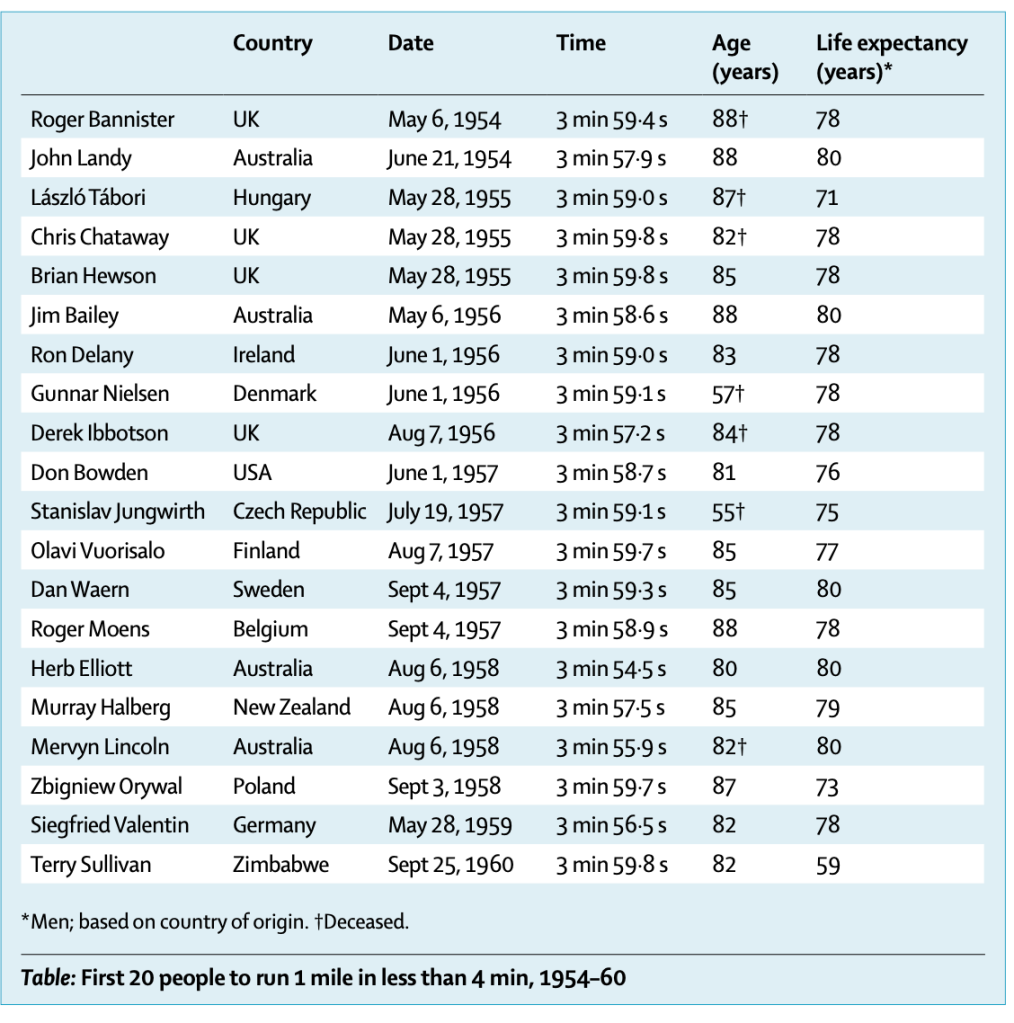The Lancet article: Maron, Barry J., and Paul D. Thompson. “Longevity in elite athletes: the first 4-min milers.” The Lancet 392, no. 10151 (2018): 913 contains an eggregious probabilistic mistake in handling “expectancy” a severely misunderstood –albeit basic– mathematical operator. It is the same mistake you read in the journalistic “evidence based” literature about ancient people having short lives (discussed in Fooled by Randomness), that they had a life expectancy (LE) of 40 years in the past and that we moderns are so much better thanks to cholesterol lowering pills. Something elementary: unconditional life expectancy at birth includes all people who are born. If only half die at birth, and the rest live 80 years, LE will be ~40 years. Now recompute with the assumption that 75% of children did not make it to their first decade and you will see that life expectancy is a statement of, mostly, child mortality. It is front-loaded. As child mortality has decreased in the last few decades, it is less front-loaded but it is cohort-significant.
The article (see the Table below) compares the life expectancy of athletes in a healthy cohort of healthy adults to the LE at birth of the country of origin. Their aim was to debunk the theory that while exercise is good, there is a nonlinear dose-response and extreme exercise backfires.
Something even more elementary missed in the Lancet article. If you are a nonsmoker, healthy enough to run a mile (at any speed), do not engage in mafia activities, do not do drugs, do not have metabolic syndrome, do not do amateur aviation, do not ride a motorcycle, do not engage in pro-Trump rioting on Capitol Hill, etc., then unconditional LE has nothing to do with you. Practically nothing.
Just consider that 17% of males today smoke (and perhaps twice as much at the time of the events in the “Date” column of the table). Smoking reduces your life expectancy by about 10 years. Also consider that a quarter or so of Americans over 18 and more than half of those over 50 have metabolic syndrome (depending on how it is defined).
Lindy and NonLindy
Now some math. What is the behavior of life expectancy over time?
Let be a random variable that lives in
and
the expectation operator under “real world” (physical) distribution. By classical results, see the exact exposition in The Statistical Consequences of Fat Tails:
If ,
is said to be in the thin tailed class
and has a characteristic scale . It means life expectancy decreases with age, owing to senescence, or, more rigorously, an increase of the force of mortality/hazard rate over time.
If ,
is said to be in the fat tailed regular variation class
and has no characteristic scale. This is the Lindy effect where life expectancy increases with age.
If where
, then
is in the borderline exponential class.
The next conversation will be about the controversy as to whether human centenarians, after aging is done, enter the third class, just like crocodiles observed in the wild, where LE is a flat number (but short) regardless of age. It may be around 2 years whether one is 100 or 120.

[…] Link to article – Some (Mis)Understanding of Life Expectancy, With Some Good News […]
LikeLike
Might title this “Comparison of Life Expectancy Statistical Apples and Oranges”.
Would like to know how similar the lives of all these individuals (but for two) were at their 60th year. Were they still running, still not smoking, etc.?
And, how did their life expectancy compare to others in their age group at the time they hit 60? (Even though there is still some Lindy effect remaining – not sure how strong this would be at 60)
LikeLike
Yes indeed I have been thinking on LE and it is not clear : are the numbers related to those born in that year of the calculation or in general. For example I am a Saudi born in 1963. LE for Saudi Arabia is now above 75 yrs, does this apply for those born this year or for all age cohorts who are alive today?!
LikeLike
Hi, if you are alive (as I assume you are) then LE doesn’t really apply. And you are right, infant mortality in 1963 was high in Arabia, so you must use that contemporaneous cohort.
LikeLike
this is possibly a bit off topic but it has been bothering me for some time now and this is as good a place as any to ask. Preface: As a youth I was naturally pretty good with/at math but my interest and my skills diverged and I went into law. So my education in math/statistics got frozen at about freshman college math levels.
Is there/are there a text or texts or a reading list which, if read conscientiously, would help me figure out NNT’s math/statistics calculations/arguments. Or at least get a better handle on them?
I hope it isn’t a rules violation but my email is stevelaudig at gmail dot com. I’d appreciate any suggestions. to avoid the “spam bin” put NN Taleb math issues in the subject box.. My instincts inform my understanding of the conclusions but it’d be nice to be able to understand how they were obtained. thanks in advance.
LikeLike